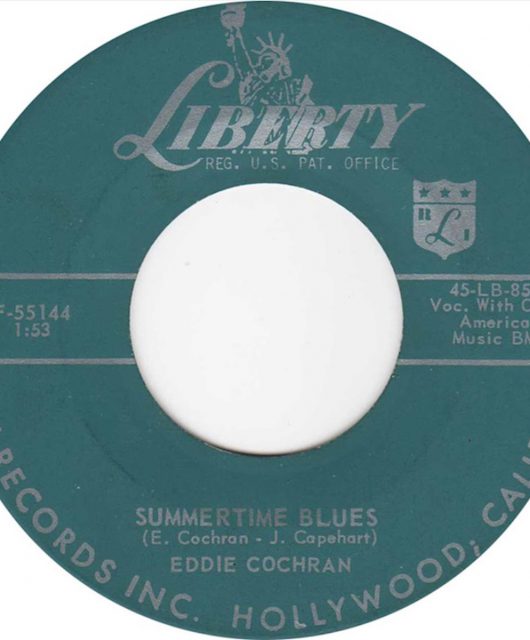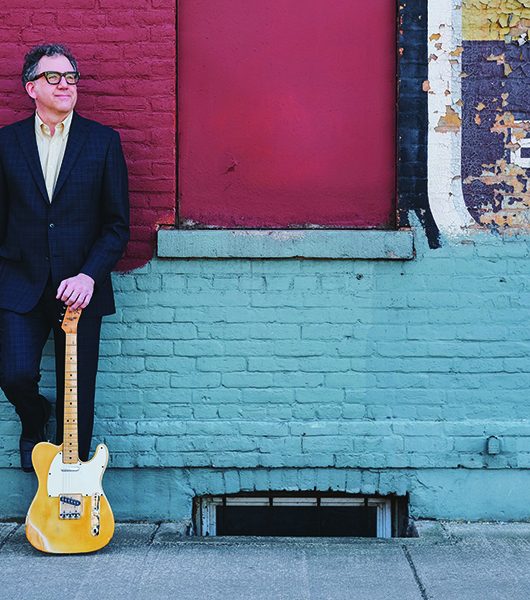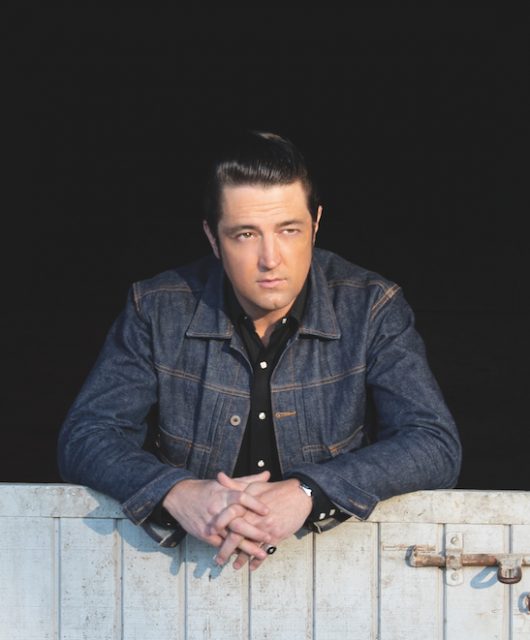Although some of their most popular songs such as Yakety Yak and Charlie Brown, recorded in New York, lay in the future, The Coasters’ eponymous debut album of 1957 reflected the creative excellence of the group’s early years in Los Angeles… By Jack Watkins
There were many outstanding vocal groups in the 1950s who traded in fancy harmonies and gorgeous melodies, but none matched The Coasters’ ability to score on the singles chart with material brimming with comic mischief
and insubordination.
Inseparable from the dynamic songwriting duo of Jerry Leiber and Mike Stoller, who also produced them, the group blended tough R&B with the slightly slicker new sound of rock’n’roll to create a series of clownish yet street-savvy classics such as Searchin’, Young Blood, Yakety Yak, Along Came Jones, Charlie Brown, Poison Ivy and Little Egypt (Ying-Yang).
Before their time ran out in the early 60s, they were the era’s great storytellers, goofy but sly, arguably only surpassed by Chuck Berry and Bo Diddley. Naturally enough, given the teenage market the songs appealed to, their albums sold less well, but their debut long-player, The Coasters, released on Atco Records in 1957, offers an excellent introduction to the first part of their story, when they were recording in Hollywood.
The Coasters had previously been known as The Robins, one of the earliest West Coast bird groups (at first they called themselves The Four Bluebirds), following the model of the likes of The Ravens and The Orioles, who were incorporating elements of R&B within their swooping harmonic arrangements.
With bass singer Bobby Nunn soon joining the original trio of Terrell Leonard, and the brothers Billy and Roy Richards, they were recording from as early as 1949 for various labels like Aladdin, Regent and Savoy. In 1951, That’s What The Good Book Says, cut for Modern, became the first ever Leiber-Stoller composition to be recorded, put out under the name Bobby Nunn with the “Robbins”. However, the relationship between the group and the two writers would not properly begin until three years later.
By 1953, the Robins were recording for RCA, where Leiber and Stoller provided them with Ten Days In Jail. When the young Jewish songwriters joined forces with Lester Sill to start their own label, Spark Records, the following year, they signed The Robins, now with Grady Chapman and subsequently Carl Gardner – a tenor from Texas who’d started out as a dance band singer in the late 1940s and who preferred to sing pop – on board.
Leiber and Stoller considered The Robins to be the perfect vehicle for humorous songs that could function as mini-stories or what Leiber liked to call “playlets”. As Stoller told Roger St. Pierre in an interview for New Musical Express in 1975: “Our secret really was that we were writing records not songs. We conceived of them as performances, much the way a play is done. That’s why we became producers, it was to protect the concept of the way our songs should be handled.”
The Coasters, made up of A- and B-sides as well as the previously unreleased Lola, contains seven numbers recorded in The Robins’ period, among them Riot In Cell Block #9, which came from a session in Los Angeles in 1954. Leiber claimed the song was simply a spoof of a cops and robbers radio show, rather than social commentary about the US penal system. Even so, he and Stoller recognised their tale of a jailhouse rebellion had sufficient meat to merit hiring the bass voice of Richard Berry, of The Flairs, to do the menacing lead vocal after Bobby Nunn’s effort at singing the part was felt to lack the necessary grit.
It should be added, alternative accounts have suggested that Nunn disliked the lyrics of Riot… and refused to sing it. The album sleeve still listed him as performing the lead part in any case. Blasting off with a bluesy, staccato riff in the Muddy Waters mode, the song was certainly hard hitting enough for several radio stations to refuse to play it.
Later given a superb, saucy new workout by Wanda Jackson, Riot In Cell Block #9, backed by the more conventional Wrap It Up, sold well enough locally, and became a template for many subsequent songs Leiber and Stoller wrote for The Coasters, as well as for their Jailhouse Rock for Elvis Presley.
The follow-up single, Framed, paired with Loop De Loop Mambo, had a similar ghetto flavour, this time with Nunn stepping up to the plate to perform the bass voice duties, as a black defendant facing a hostile, presumably all-white, court.
Next up was the unexceptional One Kiss, though this Spark release of 1955 was backed by a sensational doo-wop romp through Cole Porter’s I Love Paris, which had Grady Chapman’s glorious tenor lead and some lively harmonies sung across alternating Caribbean and R&B shuffle rhythms (sadly the recording is not included on the LP).
The next single, I Must Be Dreamin’, came from the same session. At some point during the same year, The Robins re-entered the studio to record another of their all-time classics, Smokey’s Joe’s Café, which was to be transformative for the fortunes of the group.
Telling the cautionary story of a visitor to Smokey Joe’s who is unwise enough to cosy up to the café owner’s girl, this time the lead vocal was supplied by the suitably tremulous tenor of Carl Gardner. Nunn sang the part of Smokey Joe. Easy to overlook among the vocal fireworks, as on all of the Robins/Coasters songs, was the consistent excellence of the instrumental backing.
On Smokey Joe’s Café, as elsewhere, the economical electric guitar interjections of Barney Kessel were very effective, an accomplished jazz artist who played on some of Elvis Presley’s records and film soundtracks and, perhaps most memorably, on Julie London’s torchy Cry Me A River.
Gil Bernal’s tenor sax was also a regularly reliable element in the group’s sound, before they relocated to New York, and guitarist Adolph Jacobs, a regular from the mid-50s into their New York years, was classed as a group member.
The apparent spontaneity of the Robins/Coasters songs was the result of perseverance, with multiple takes required and long periods spent rehearsing harmonies which did not come as naturally to them as with some other contemporary vocal groups. Stoller would describe The Coasters as “a vaudeville act” to Roger St. Pierre, but he and Leiber were alive to comedy themselves.
Leiber would prance around the room acting out and singing the baritone or tenor parts. “I think the most fun we ever had working with any artists, including Elvis Presley, was with The Coasters,” the more laid-back Stoller told Ted Fox for his In the Groove: The People Behind The Music. “We’d be falling on the floor – all of us – and staggering around the room holding our bellies because we were laughing so hard.”
Smokey’s Joe’s Café sold well, but Spark lacked the resources to fully promote the song. The New York-based Atlantic Records had already shown interest in acquiring the distribution rights to Riot In Cell Block #9, but Lester Sill had held out for a while, fearing The Robins would take low rank behind Atlantic’s already well-established vocal groups, The Clovers and The Drifters.
However, this time Atlantic boss Ahmet Ertegun was able to secure the rights to re-release Smokey Joe’s Café on his new subsidiary label, Atco. Spark was wound up, with Atlantic acquiring their catalogue, and Leiber and Stoller joining the company as independent producers.
Not only would Smokey Joe’s Café make the US Top 10 on the R&B chart, it gave the Robins their first and only, admittedly lowly, placing on the Billboard Pop chart at the tail end of 1955.
The consensus among the management and most members of The Robins, however, was to spurn the opportunity to sign for Atlantic, which meant that only two from the group, Carl Gardner and Bobby Nunn followed Leiber and Stoller.
Augmented by baritone Billy Guy, on Gardner’s recommendation, and as second tenor, Leon Hughes, they became part of a new group named The Coasters, as a nod to their West Coast base. The Robins now effectively departed from the picture, although they remained as an entity in their own right, continuing to record for small
L.A. labels with limited success into the early 1960s.
The first Coasters single released on Atco featured the superb Down In Mexico, which followed a similar formula to
Smokey Joe’s Café, backed by the breezy Turtle Dovin’ the latter with a typically fine vocal by Gardner and a lengthy sax solo from Bernal.
An Billboard R&B chart success (No.8), the single was followed by another bright pairing: the cheeky One Kiss Led To Another and an inspired doo-wop stab at a standard, Brazil, on which Nunn, Guy and Gardner took turns to share the lead vocal.
Both Gardner and Guy were favourites of Leiber and Stoller, according to Hound Dog – The Leiber And Stoller Autobiography, written together with David Ritz, in which Leiber referred to Gardner’s “exquisite” tenor voice, while Stoller described Guy as “the comic. He had great timing and loved to play the country yokel. In real life, he was city-sharp and super-hip.”
One Kiss Led To Another made a brief appearance at the foot of the Billboard Pop chart. But the real breakthrough single came a year later, at The Coasters’ final Hollywood session. Four tracks were recorded: Lola, Sweet Georgia Brown and, most significantly, Searchin’, the lead sung by Guy, and Young Blood, performed by Carl Gardner.
These last two were paired to make a double-sided smash, reaching No.3 and No.8 respectively on the Billboard Hot 100 in May 1957. Searchin’ was also the first Coasters record to chart in Britain.
The Coasters would go on to even greater commercial success in the years that followed, recording with Leiber and Stoller in New York. But, to paraphrase the title of one of their later singles, “the secret of their success” lay in the creative ingredients that was put together during those earlier recordings in Hollywood which comprise The Coasters.






